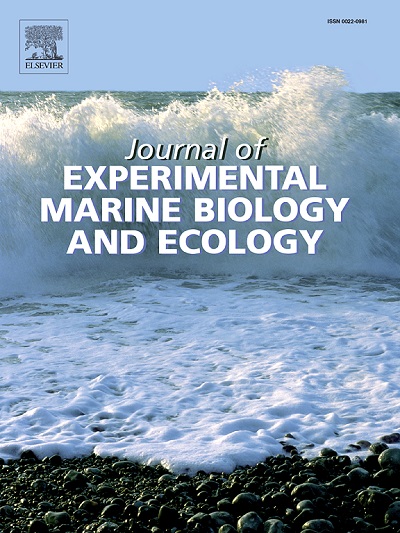光对珊瑚表型对急性热应力反应的不同影响
IF 1.8
3区 生物学
Q3 ECOLOGY
Journal of Experimental Marine Biology and Ecology
Pub Date : 2024-09-28
DOI:10.1016/j.jembe.2024.152057
引用次数: 0
摘要
由于气候变化和其他压力,珊瑚礁珊瑚在全球范围内逐渐减少。然而,珊瑚对热应力的生理反应差异很大。在描述珊瑚热耐受性变化的特征时,光的影响往往被忽视。因此,我们利用来自两个栖息地的珊瑚,在急性热应力实验中研究了光照水平如何影响光化学和白化反应,这些反应通常会影响珊瑚的热耐受性。尽管不同地点的温度机制存在自然差异,但两个珊瑚种群在不同季节对急性热应力的反应相似。热胁迫(冬季:+9 °C,夏季:+7.5 °C)后光化学响应(Fv/Fm)的平均下降幅度较小(≤ 6%),表明没有光胁迫,但与弱光处理(4-11 DLI)相比,强光处理(16-24 日光照积分,DLI)下的光化学响应持续增强。Fv/Fm 的反应因基因型而异(相对变化从 +3 % 到 -50%),尽管 Fv/Fm 的下降幅度较小,但所有基因型在夏季都会失去色素(组织颜色的相对变化从 10 % 到 45 % 不等),而且无论光照处理如何,色素都会明显变淡。这些结果凸显了漂白反应对温度和光胁迫等主要驱动因素的复杂性。需要进一步研究了解不同研究中光照水平对急性热应力反应的影响,尤其是在热耐受性基于单一表型的情况下。将光照作为热应力指标的一个促成因素,将促进我们对珊瑚温度阈值的理解,从而改进基于普遍环境驱动因素的珊瑚白化预测。本文章由计算机程序翻译,如有差异,请以英文原文为准。
Differential impacts of light on coral phenotypic responses to acute heat stress
Reef building corals are in global decline due to climate change and other pressures. Yet, corals show wide variation in physiological responses to heat stress. The influence of light is often dismissed when characterising variation in coral thermal tolerance. Hence, we investigate how light levels affect the photochemical and bleaching responses that typically inform coral thermal tolerance in acute heat-stress experiments using corals from two habitats. Despite natural variations in temperature regimes between sites, both coral populations responded similarly to acute heat-stress across seasons. The decline in the photochemical response (Fv/Fm) after heat stress (winter: +9 °C, summer: + 7.5 °C) was small on average (≤ 6 %) indicating no light stress, but consistently greater in high light (16–24 Daily light integrals, DLI) compared to low light treatments (4–11 DLI). Fv/Fm responses varied per genotype (+3 % to −50 % relative change) and despite small declines in Fv/Fm, all genotypes lost pigment in summer (10 % to 45 % relative change in tissue colour) and paled significantly irrespective of light treatment. These results highlight the complexity of the bleaching response to the primary drivers of temperature and light stress. Further research is needed to understand how light levels affect acute heat-stress responses across studies particularly when thermal tolerance is based on single phenotypes. Incorporating light as a contributing factor to thermal stress indicators will advance our understanding of coral temperature thresholds, to improve coral bleaching predictions based on ubiquitous environmental drivers.
求助全文
通过发布文献求助,成功后即可免费获取论文全文。
去求助
来源期刊
CiteScore
4.30
自引率
0.00%
发文量
98
审稿时长
14 weeks
期刊介绍:
The Journal of Experimental Marine Biology and Ecology provides a forum for experimental ecological research on marine organisms in relation to their environment. Topic areas include studies that focus on biochemistry, physiology, behavior, genetics, and ecological theory. The main emphasis of the Journal lies in hypothesis driven experimental work, both from the laboratory and the field. Natural experiments or descriptive studies that elucidate fundamental ecological processes are welcome. Submissions should have a broad ecological framework beyond the specific study organism or geographic region.
Short communications that highlight emerging issues and exciting discoveries within five printed pages will receive a rapid turnaround. Papers describing important new analytical, computational, experimental and theoretical techniques and methods are encouraged and will be highlighted as Methodological Advances. We welcome proposals for Review Papers synthesizing a specific field within marine ecology. Finally, the journal aims to publish Special Issues at regular intervals synthesizing a particular field of marine science. All printed papers undergo a peer review process before being accepted and will receive a first decision within three months.

 求助内容:
求助内容: 应助结果提醒方式:
应助结果提醒方式:


